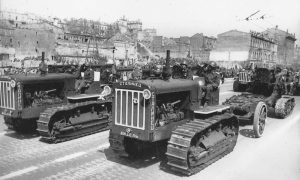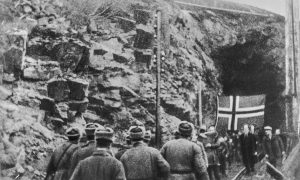Why did the Soviets Use The Maxim machine gun?
The Maxim PM1910 machine gun 1910 model is a heavy machine gun of the Maxim machine gun Family, which was widely used by the Russian and Red armies during the First World War and the Second World War. The machine gun was used to engage open groups of targets and enemy fire weapons at a distance of up to 1000 m. By September 22 1939 the year on weapons was adopted by the Red Army “7.62-mm machine gun mod. 1939 DS-39”, which was intended to replace the Maxim machine guns. However, the operation of the DS-39 in the troops revealed design flaws, as well as the unreliability of the functioning of the automation when using cartridges from a brass sleeve (for the reliable functioning of the automation, the DS-39 required cartridges with a steel sleeve).
What is the History of the Maxim PM1910 Machine Gun?
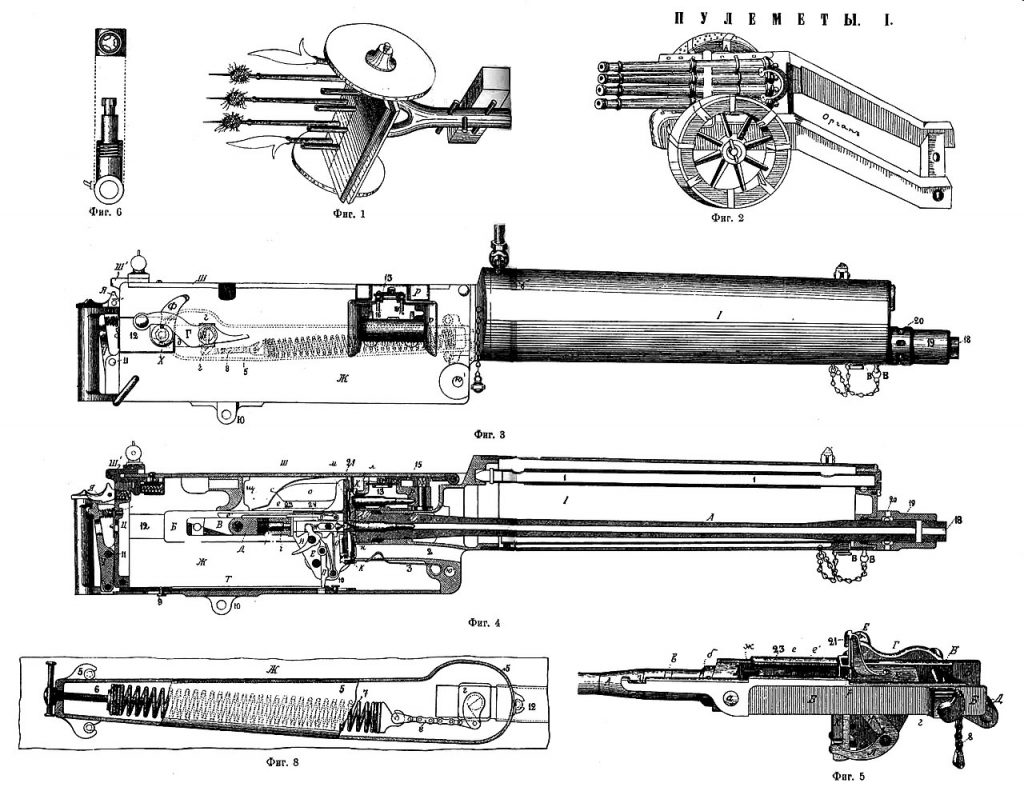
Maxim Machine Gun Diagrams
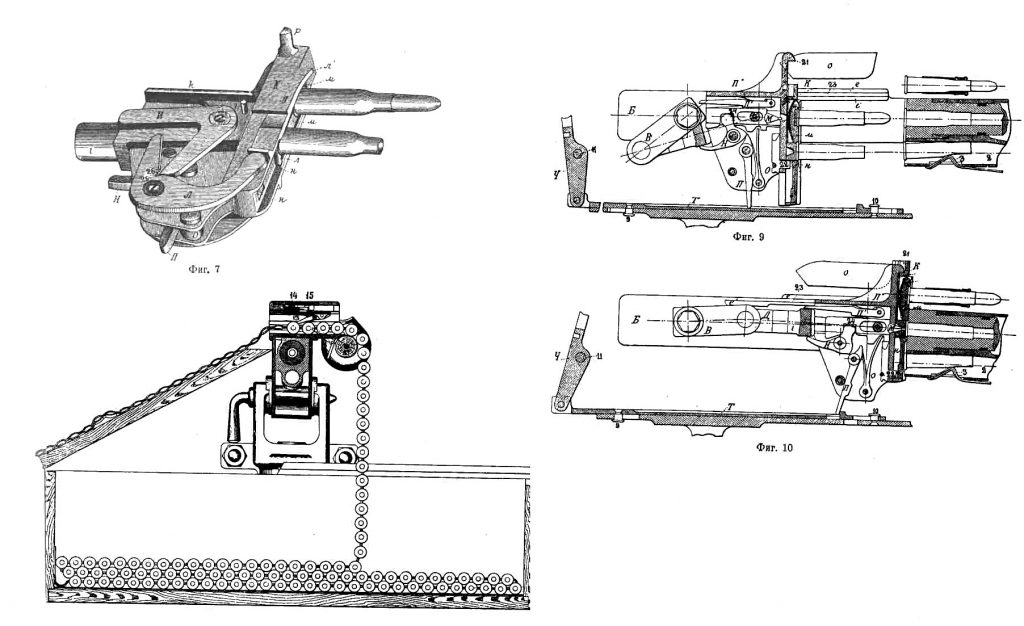
After a successful demonstration of the machine gun in Switzerland, Italy and Austria-Hungary, Hiram Maxim arrived in Russia with a demonstration model of a .45 caliber (11.43 mm) machine gun. In 1887, the Maxim machine gun was tested for a 10.67-mm Berdan rifle cartridge with black powder.
On March 8, 1888, it was shot by Emperor Alexander III. After the tests, representatives of the Russian military department ordered Maxim 12 machine guns mod.1895 under the 10.67-mm cartridge of the Berdan rifle.
Vickers, Sons & Maxim began supplying Maxim machine guns to Russia. The machine guns were delivered to St. Petersburg in May 1899. The Russian navy also became interested in the new weapon ; it ordered two more machine guns for testing. Subsequently, the Berdan rifle was removed from service, and the Maxim machine guns were redesigned for the 7.62-mm cartridge of the Russian Mosin rifle. In 1891-1892. for testing were purchased five machine guns chambered for 7.62x54mm.
To improve the reliability of the 7.62-mm machine gun’s automation, a “muzzle booster” was introduced into the design – a device designed to use the energy of powder gases to increase the recoil force. The front of the barrel was thickened to increase the muzzle area and then a muzzle cap was attached to the water jacket. The pressure of the powder gases between the muzzle and the cap acted on the muzzle of the barrel, pushing it back and helping it roll back faster.
In 1901, the 7.62-mm Maxim machine gun on an English-style wheeled carriage was adopted by the ground forces, during this year the first 40 Maxim machine guns entered the Russian army. In general, during 1897 – 1904, 291 machine guns were purchased.
The machine gun (the mass of which on a heavy gun carriage with large wheels and a large armor shield was 244 kg) was assigned to artillery. Machine guns were planned to be used for the defense of fortresses, for repulsing by fire from pre-equipped and defended positions of massed attacks by enemy infantry. This approach may cause confusion: even during the Franco-Prussian war, French mitrailleuses , used in an artillery manner, that is, with batteries , were suppressed by Prussian counter-battery fire due to the obvious superiority of artillery over small-caliber weapons in range.
In March 1904, a contract was signed for the production of Maxim machine guns at the Tula Arms Plant. The cost of producing the Tula machine gun (942 rubles + 80 pounds sterling of the commission to the Vickers firm, only about 1700 rubles) was cheaper than the cost of purchse from the British (2288 rubles 20 kopecks for a machine gun). In May 1904, mass production of machine guns began at the Tula Arms Plant.
At the beginning of 1909, the Main Artillery Directorate announced a competition for the modernization of the machine gun, as a result of which a modified version of the machine gun was adopted in August 1910: the 7.62-mm Maxim machine gun of the 1910 model, which was modernized at the Tula Arms Factory under the leadership of technical staff officer P.P. Tretyakov, craftsmen I.A.Pastukhov and I.A. Sudakov. The weight of the machine gun body was reduced and some parts were changed: a number of bronze parts were replaced with steel ones, the sights were changed to match the ballistics of the cartridge with a pointed bullet of the model of 1908, the receiver was changed to fit the new cartridge, and the bore of the muzzle sleeve was also widened. The English wheeled carriage was replaced with a lightweight wheeled machine by A.A. Sokolov, the English-style armor shield was replaced with a reduced-size armor shield. In addition, A. A. Sokolov designed ammunition boxes, a cart for transporting cartridges, sealed cylinders for boxes with cartridges.
In the course of the combat use of the Maxim machine gun, it became clear that in most cases the fire was conducted at a distance of 800 to 1000 meters, and at such a distance there was no noticeable difference in the trajectory of light and heavy bullets.
In 1930, the machine gun was upgraded again. The modernization was carried out by P. P. Tretyakov, I. A. Pastukhov, K. N. Rudnev and A. A. Tronenkov. The following changes have been made to the design: A folding butt plate was installed, in connection with which the right and left valves and the connection of the release lever and the rod were changed the fuse is moved to the trigger, which eliminates the need to operate with both hands when opening fire the indicator of the tension of the return spring is installed. The sight was changed, a stand and a clamp with a latch were introduced, the scale on the rear sight of the side corrections was increased a buffer appeared – a holder for a shield, attached to the casing of the machine gun a separate striker was introduced to the striker for firing at long distances and from closed positions, a heavy bullet mod. 1930, telescopic sight and protractor – quadrant for greater strength, the barrel casing is made with longitudinal corrugation.
The modernized machine gun was named “7.62 easel machine gun of the Maxim system, model 1910/30”. In 1931, a more advanced universal machine gun arr. 1931 of the SV Vladimirov system and a PS-31 machine for long-term firing points were developed and adopted.
In the 1930s, under the leadership of SA Ivanenko, a remote-controlled version of the Maxim machine gun with control by wire was developed.
In 1936, engineer M. I. Popov developed the Luch system, which made it possible to fire from a Maxim machine gun on the Sokolov machine gun along a predetermined line with automatic horizontal dispersion. In January-March 1937, the “Luch” system was tested at the Research and Testing Range of Small Arms of the Red Army.
By the end of the 1930s, the design of the machine gun was morally obsolete, primarily due to its large weight and size.
Maxim Machine Gun in WW2
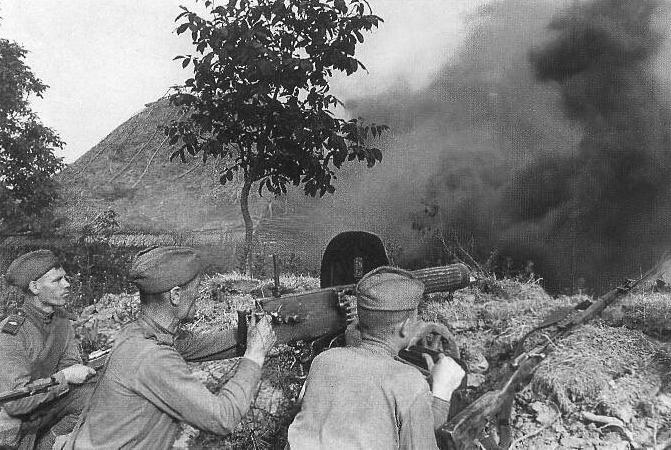
Maxim Machine Gun in combat
During the Finnish war of 1939-1940. the combat capabilities of the Maxim machine gun tried to increase not only the designers and manufacturers, but also directly in the troops. In winter, the machine gun was installed on skis, sledges or drag boats, on which the machine gun was moved through the snow and from which, if necessary, fired. In addition, in the winter of 1939-1940, there were cases when machine gunners mounted on the armor of tanks installed Maxim machine guns on the roofs of tank turrets and fired at the enemy, supporting the advancing infantry.
In 1940, in the barrel water cooling jacket for quick water changes, the small diameter water filling hole was replaced with a wide mouth. This innovation was borrowed from the Finnish Maxim (Maxim M32-33) and allowed to solve the problem of the lack of access to the coolant in the calculation in the winter, now the casing could be filled with ice and snow.
After the start of World War II, in June 1941, the DS-39 was discontinued and the enterprises were ordered to restore the curtailed production of Maxim machine guns.
In June 1941, at the Tula Arms Plant, under the leadership of Chief Engineer A. A. Tronenkov, engineers I. E. Lubenets and Yu. A. Kazarin began the final modernization (in order to improve the manufacturability of production), during which the “Maxim” was equipped with a simplified sighting attachment (with one aiming bar instead of two, which were previously replaced depending on the shooting with a light or heavy bullet), the mount for the optical sight was removed from the machine gun mount.
The Maxim machine gun was actively used in WW2. It was in service with rifle and mountain rifle units, border guards, the navy, and was installed on armored trains, Willis and GAZ-64 jeeps.
In May 1942, by order of the USSR People’s Commissar of Armaments D.F.Ustinov, a competition was announced for the development of a new heavy machine gun for the Red Army (to replace the Maxim machine gun model 1910/30), work to reduce the weight of the machine gun continued in the following: in the 43rd Infantry Division of the Leningrad Front (which fought in forest and swampy areas), a light tripod for the Maxim machine gun weighing 5.6 kg was developed, which was produced for the troops of the Leningrad Front; in 1944, an improved tripod for a machine gun was developed in the 18th Army “Maxim”.
On May 15, 1943, the Red Army adopted a heavy machine gun of the Goryunov SG-43 system with an air barrel cooling system, which began to enter the troops in June 1943. But the Maxim machine gun remained the main machine gun of the Red Army until the end of the war and continued to be produced by enterprises in the structure of the People’s Commissariat of Armaments – at plant number 74 and plant number 524 in Izhevsk, plant number 535 and plant number 536 in Tula, plant number 66 and plant number 385 in Zlatoust, plant number 106 in Khabarovsk…
Machine-gun belts “Maxima” were manufactured by the “Spayka” artel of the Criminal Procedure Code of the SNK of the RSFSR in Sivtsevoy Vrazhka in Moscow, by the factory named after V.I. Roses Luxemburg NKLP in Kiev.
The largest manufacturer of machine guns was the Tula Arms Plant (TOZ, plant No. 536 in the USSR), which provided production figures for 8637 Maxim machine guns per year in the pre-war period (1933). Production figures for Maxim machine guns reached 4900 per month in December 1944. In January 1945, the Chairman of the State Defense Committee JV Stalin ordered to reduce the production of Maxim machine guns to 1000 per month. Izhevsk became the largest wartime manufacturer – about 77,000 machine guns produced there at the end of World War II. By April 1945, about 51,000 machine guns were manufactured at the Tula Arms Plant, and the Leningrad Machine Building Plant produced 1975 machine guns.





